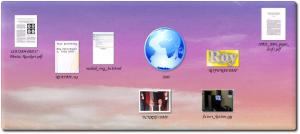Name Collision

When names collide
 ACK in 2002, I chose to work on a project which dealt with the game Othello, also known as Reversi. To put rigour into development, I chose a name for it. I did so without paying much thought to any future potential. A careful and exhaustive investigation of name collisions simply did not seem worthwhile at the time.
ACK in 2002, I chose to work on a project which dealt with the game Othello, also known as Reversi. To put rigour into development, I chose a name for it. I did so without paying much thought to any future potential. A careful and exhaustive investigation of name collisions simply did not seem worthwhile at the time.
Having searched the Web at a shallow level, I did not know of any name collisions when I chose the title “Othello Master”. I even explained about the choice of the name in my report and proposal. It refelects on the way I viewed the choice of the name at that time:
This project has been set to produce an application which will be titled Othello Master due to some visual similarity to an older game called Chess Master. It will require knowledge of game theory and advanced computer graphics.
The name was therefore conceived in a most innocent way. It was only less than a year ago that I became aware of a name collision, for which I am to blame. Search engines had revealed a game from the mid-eighties, which suddenly resurfaced in results from archival pages. It ran on the Amiga, but perhaps on other platforms too.
I sometimes wonder if I should get a hold of this game and play it. Mine is Open Source and GPL‘d so no-one is prevented from playing it for free. In fact, the downloads page is always there for those interested. As for the number of downloads, I believe it itches 1,000, but I rarely keep track of the numbers. It can run on all platforms and there is even a Windows executable.
Other items on Othello Master:






 Filed under:
Filed under: 
 ODULARITY or compartmentalisation, at least in the context of programming, are important and fundamental concepts. They accommodate for easy extension or change of any piece of software. In the context of Web design, elements to be dealt with apart are layout and content, as the former virtually ‘wraps’ the latter.
ODULARITY or compartmentalisation, at least in the context of programming, are important and fundamental concepts. They accommodate for easy extension or change of any piece of software. In the context of Web design, elements to be dealt with apart are layout and content, as the former virtually ‘wraps’ the latter. LATEX: TeX styles are a similar scenario where consistent styling is easily achieved. Change can be applied to entire document where semantic structure has been embedded by the author. This, in fact, is why many books and eclectic conference proceedings are assembled using LATEX.
LATEX: TeX styles are a similar scenario where consistent styling is easily achieved. Change can be applied to entire document where semantic structure has been embedded by the author. This, in fact, is why many books and eclectic conference proceedings are assembled using LATEX.
 have already introduced my latest Open Source project (namely
have already introduced my latest Open Source project (namely  HERE are a variety of technique for summarising page content. Excerpts may be considered one of them, metadata in the (X)HTML header might be another. There is also a sharp rise in the use of tags, which can easily infer the ‘theme’ of a page a and can cohesively reflect on trends across sites (confer
HERE are a variety of technique for summarising page content. Excerpts may be considered one of them, metadata in the (X)HTML header might be another. There is also a sharp rise in the use of tags, which can easily infer the ‘theme’ of a page a and can cohesively reflect on trends across sites (confer 

 ERTAIN issues arise when habits and user orientation in his/her desktop are interfered with. Desktop environments, installers, filesystem structures, or even platforms in general are often more workable and thus successful if they comply with the expectation of new users. What if these are made too stringent by the developers, however? What if decisions and conventions are voted for without involvement of the end-user?
ERTAIN issues arise when habits and user orientation in his/her desktop are interfered with. Desktop environments, installers, filesystem structures, or even platforms in general are often more workable and thus successful if they comply with the expectation of new users. What if these are made too stringent by the developers, however? What if decisions and conventions are voted for without involvement of the end-user? A long time ago I mentioned
A long time ago I mentioned